2- Laterally Loaded Piles
1.0 Introduction
This tutorial demonstrates how to analyze a single pile in multiple soil layers under various conditions in RSPile. Before proceeding with the tutorial, make sure you’ve gone through Tutorial 01 - RSPile Quick Start so you’re familiar with the product’s basic functions and features.
Topics Covered in this Tutorial:
- Multi-layer model
- Soil types for laterally loaded piles
- Pile properties
- Lateral loading conditions
- Export data to Excel
Finished Product:
The finished product of this tutorial can be found in the Tutorial 2 - Lateral Pile Analysis.rspile2 data file. All tutorial files installed with RSPile can be accessed by selecting File > Recent Folders > Tutorials Folder from the RSPile main menu.
2.0 Model
When the RSPile program is started, a new blank document is already opened, allowing you to begin creating a model immediately.
2.1 PROJECT SETTINGS
The Project Settings is where you can change the analysis type, tolerance, number of iterations allowed, and the number of pile segments to be used in the analysis. To open the Project Settings:
- Select Home > Project Settings
 (CTRL + J).
(CTRL + J). - Go to the Pile Analysis Type tab.
- Select Individual Pile Analysis = Laterally Loaded.
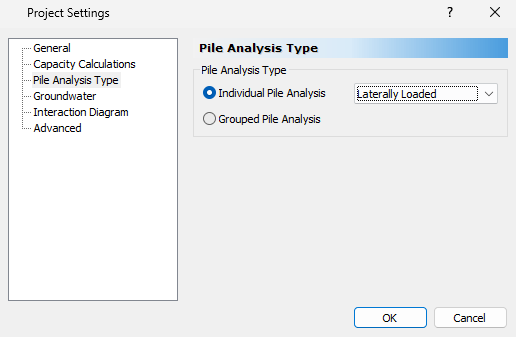
- Click OK to close the dialog.
Notice that in addition to the Axially Loaded and Laterally Loaded options, under the Individual Pile Analysis header we also have an Axially / Laterally Loaded option. We have provided the Axially / Laterally Loaded analysis type specifically for RSPile integration with Slide2.
2.2 SOIL PROPERTIES
- Select Soils > Define Soil Properties
 (CTRL + 8).
(CTRL + 8). - Enter the following soil properties:
- Name = Soft Clay
- Unit Weight = 15 kN/m3
- Soil Type = Soft Clay Soil
- Strain Factor = 0.02
- Undrained Shear Strength = 32 kPa
- Name = Sand
- Unit Weight = 20 kN/m3
- Soil Type = Sand
- Friction Angle = 35 degrees
- Kpy (kN/m3)= 16300 kN/m3
- Click OK to save your input and exit the dialog.
In this dialog, you can define the properties related to the Q-z, t-z, and p-y curves. There is a tab for the analysis type that you specified in the Project Settings (in this case, Lateral) as well as for datum dependency. The Datum Dependency tab allows users to control linearly varying properties.
Soil Property 1:
Soil Property 2:
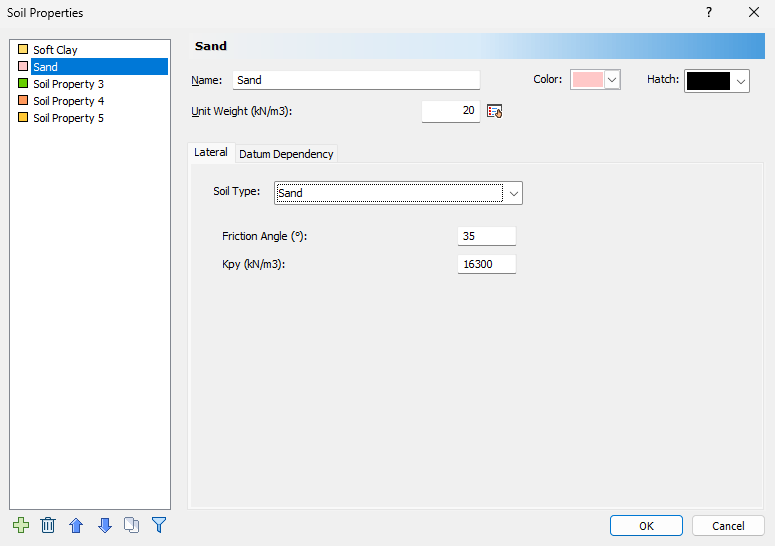
2.3 SOIL PROPERTIES
RSPile supports multiple boreholes and non-horizontal soil strata. When multiple boreholes are defined, the program will automatically interpolate between the boreholes. In this tutorial, we will model horizontal soil strata with a single borehole. To begin:
- Select Soils > Edit All
 to open the Edit Boreholes dialog.
to open the Edit Boreholes dialog. - Click on Insert Layer Below
 to add another layer below the first. The Name column will fill in by soil property sequence.
to add another layer below the first. The Name column will fill in by soil property sequence. - Specify the following layer thicknesses:
- Click OK to save your input and exit the dialog.
The default soil column has a single layer and is located at (0, 0). To change the Location, enter coordinates for X and Y. We will keep it (0,0) here.
Layers are defined by thickness by default, but may be defined by top and bottom elevation. This may be changed by toggling Define Layers by Thickness.
# | Name | Thickness | Top Elevation | Bottom Elevation |
1 | Soft Clay | 10 | 0 | -10 |
2 | Sand | 10 | -10 | -20 |
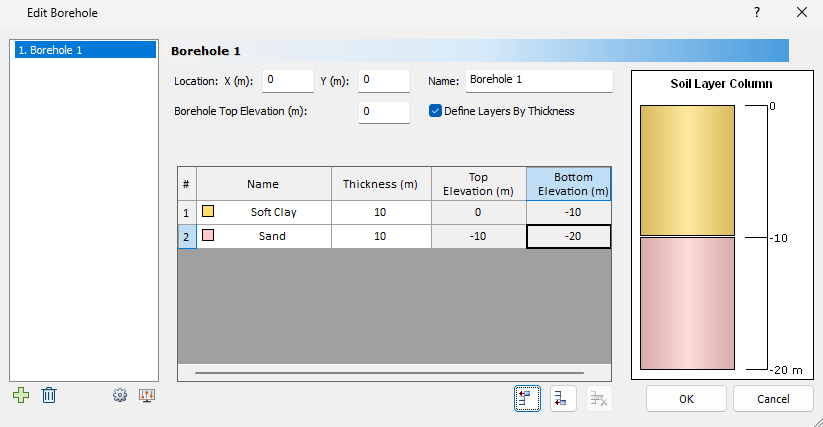
The Soil Layer Column on the right side of the dialog will update automatically as layer thicknesses are defined.
2.4 PILE SECTION PROPERTIES
- Select Piles > Pile Sections
 to open the Define Pile Section Properties dialog.
to open the Define Pile Section Properties dialog. - Select Pile 1 and enter the properties displayed in the table below:
- Click OK to save your input and exit the dialog.
Name | Cross Section | Type | Pile Outside Diameter (m) | Pipe Wall Thickness (m) | Young's Modulus (kPa) |
Steel Pipe | Pipe | Elastic | 0.5 | 0.02 | 200000000 |
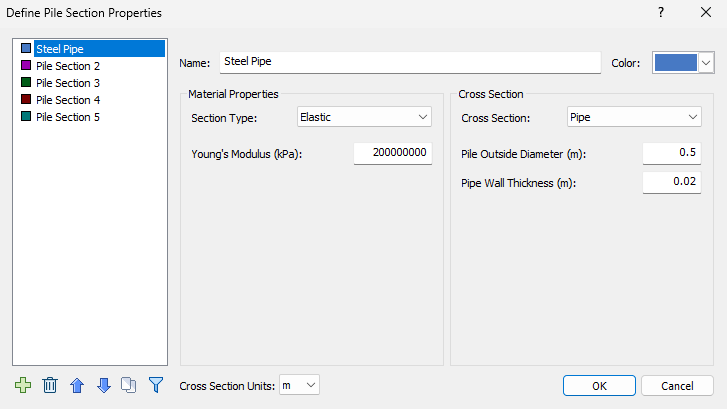
2.5 ADDING A PILE
- Select Piles > Single
 to open the Add Pile dialog.
to open the Add Pile dialog.
We have centralized all aspects of the pile definition in the Add Pile dialog. For the Axially Loaded, Laterally Loaded and Axially / Laterally Loaded analysis types the Add Single Pile and Add Pile Pattern options are available. For the Grouped Pile Analysis type, the Cap Designer must be used. In the Add Pile dialog, users specify:
- Geometry – basic pile properties such as location and pile type
- Loading – pile head loading definition
- Tractions - applied distributed loads
- Displacement – displacement profile or axial /lateral resistance analysis
- Multipliers – p-y, t-z, Q-z multipliers can be defined
- Advanced – advanced analysis options such as Pile Length Analysis (the availability of the Advanced options varies based on pile analysis type)
2.5.1 Geometry
The Geometry tab allows users to specify the pile type and location of a single pile.
The pile type selected determines the pile sections the pile is composed of, the pile length and the alignment of the single pile. Alignment options include: elevation, ground slope angle, rotation angle, and orientation. Orientation may be specified in one of two ways: Alpha angle, or Vector position.

For this tutorial:
- Click on the Edit
 icon for the Pile Type and enter the following properties for Pile Type 1:
icon for the Pile Type and enter the following properties for Pile Type 1: - Click OK to close the Edit Pile Types dialog.
Pile Property | Pile Head Elevation (m) | Length (m) | Orientation | |||
Alpha Angle | Rotation Angle | |||||
Steel Pipe | 0 | 19 | 0 | 0 | ||
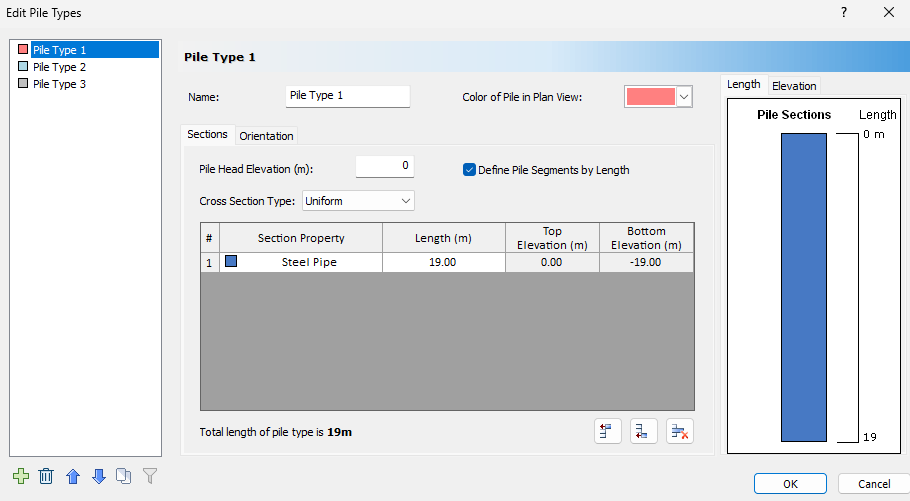
2.5.2 Loading
- Select the Loading tab.
- Add a new Loading Property by clicking on the Add
 button.
button. - Add two new loads under Load Property 1 by clicking on the Add
 button at the bottom of the dialog.
button at the bottom of the dialog. - Specify the following types and values:
- Click OK to save settings and close the dialog.
RSPile provides users with the flexibility to analyze multiple piles in a single file, and the Loading Property manager tracks all the pile head loads for the entire model. A different Load Property can be defined for each pile, or the same Load Property can be used for all of the piles in the file.
With regards to load type, two options are available: cyclic or static loading. If cyclic loading is chosen, the number of load cycles may be specified, depending on the soil types used.
Multiple loads may be added under each load property.
Type | Value |
Moment Y (kNm) | 100 |
Force X (kN) | 50 |
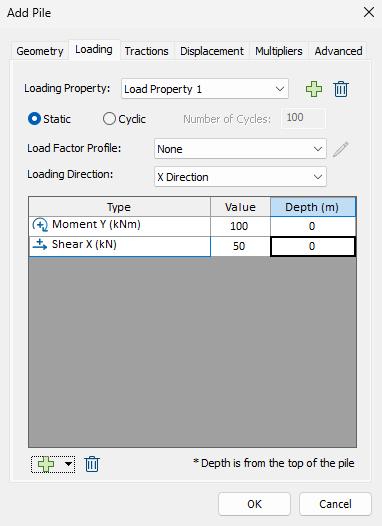
The Tractions, Displacement, Multipliers, and Advanced tabs will be explored in later tutorials.
2.5.3 Placement
After clicking OK, RSPile will prompt the user to enter the (x, y) coordinates of the new single pile. You may enter the location manually in the bottom right of the screen, or click a point on the Plan View to place it.
- Enter Location = (0, 0) in the bottom right of the screen.
- Press Enter to place the pile.
Your model should now look like this:
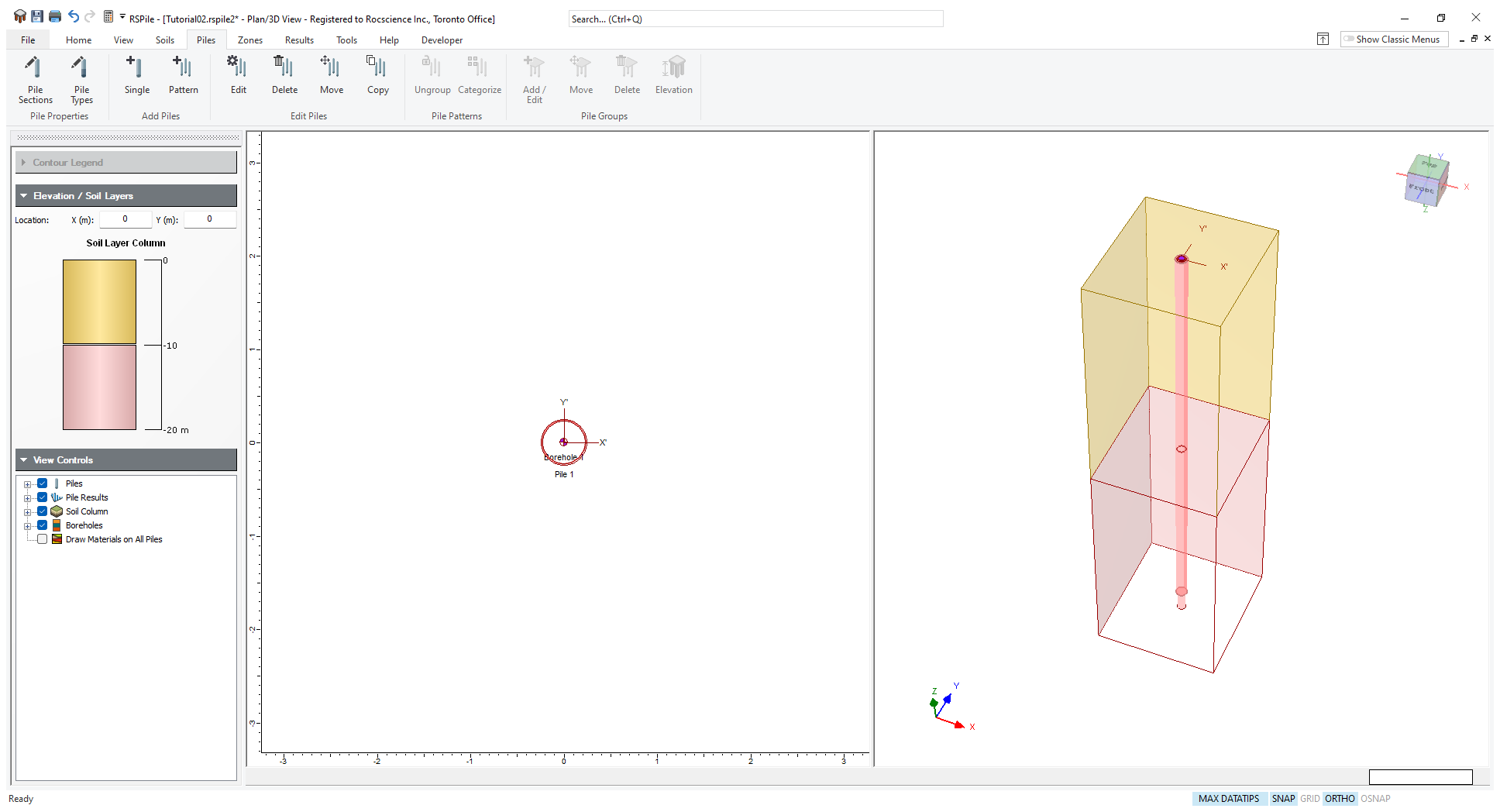
Notice that the soil column has now updated to reflect the strata.
3.0 Results
- Save and compute the file by selecting Results > Compute

3.1 RESULT VISUALIZATION
RSPile allows for the 3D visualization of results along the length of the pile.
Pile Results may be toggled on or off using the View Controls in the sidebar.
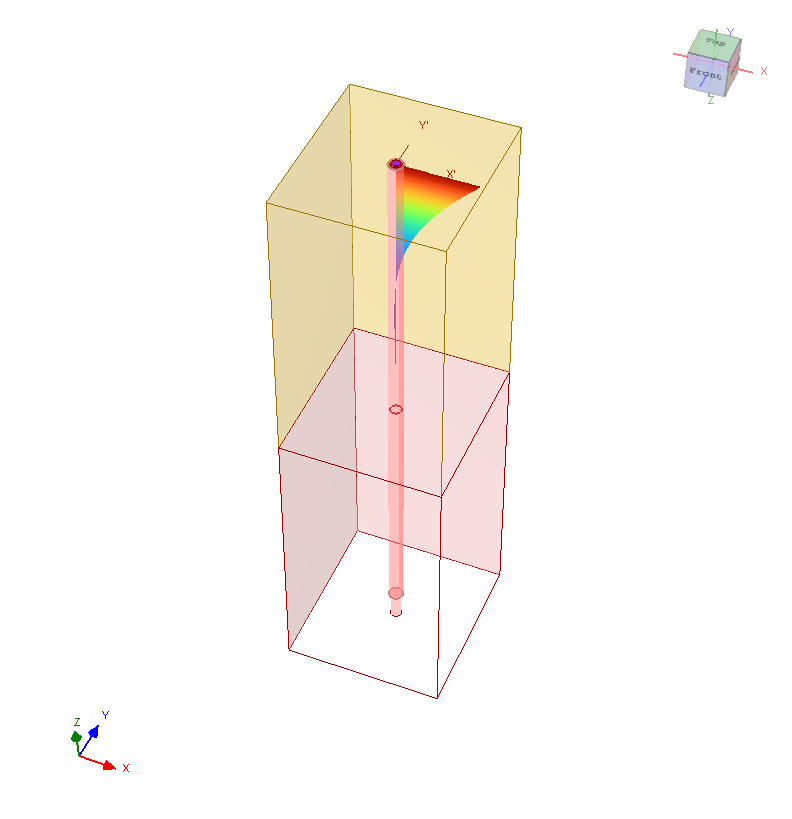
Use the Data Type drop down to control what results are shown.

For a lateral analysis, the following results are available:
- Displacement X
- Displacement Y
- Displacement Z
- Rotation X
- Rotation Y
- Rotation Z
- Beam Shear Force X'
- Beam Shear Force Y'
- Beam Axial Force
- Beam Moment X'Z'
- Beam Moment Y'Z'
- Soil Reaction Force X'
- Soil Reaction Force Y'
- Soil Reaction Force Z'
- Soil Stiffness X'
- Soil Stiffness Y'
- Soil Stiffness Z'
- Skin Friction
- End Bearing
3.2 CHARTS
- Right-click on the pile and select Graph Pile
 .
.
The RSPile results section presents several default graphs and a table of results. You should see the following:
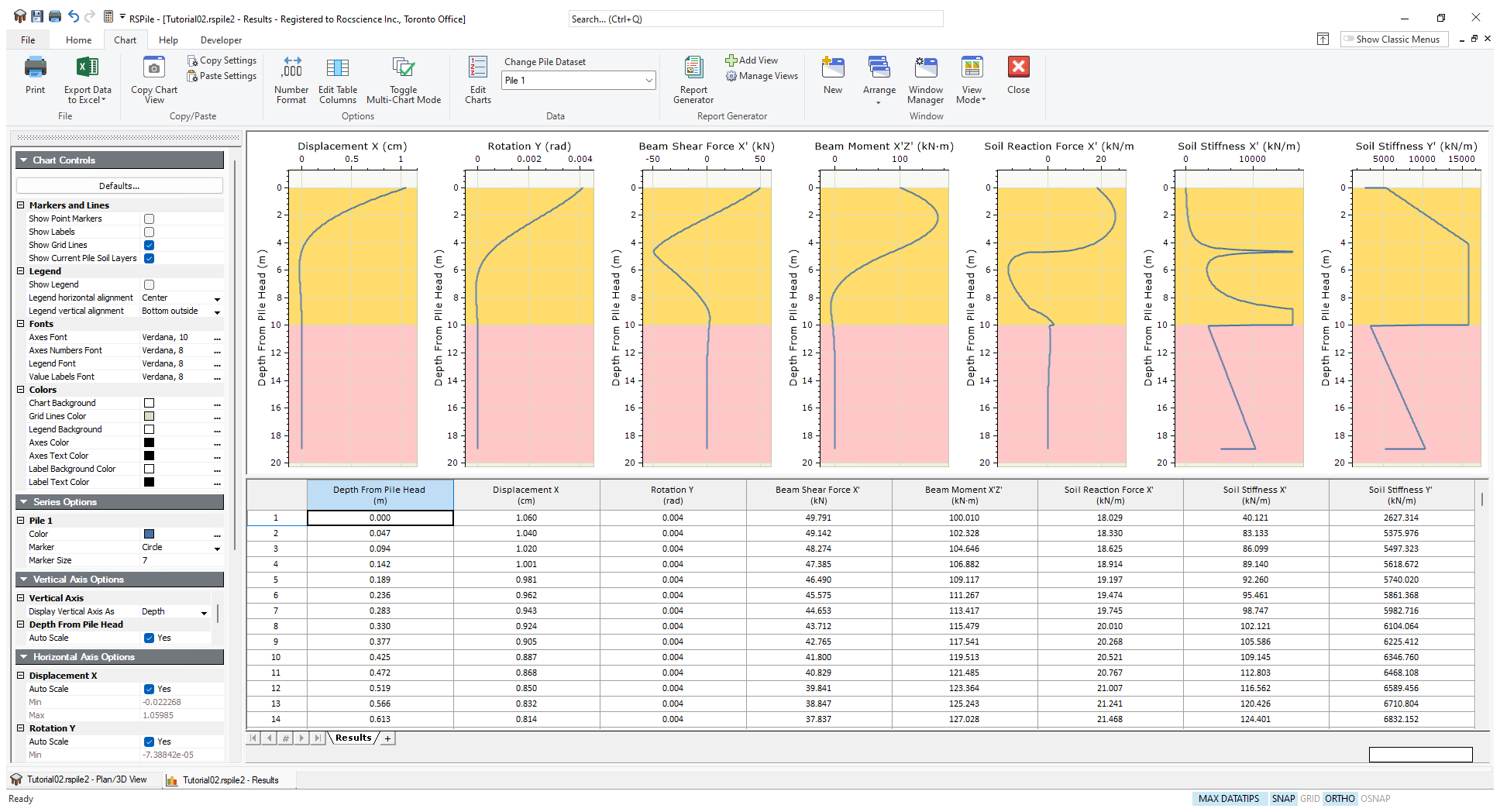
Lateral pile analysis generates the following default graphs:
- Displacement vs. Depth
- Rotation vs Depth
- Beam Shear Force vs. Depth
- Bending Moment vs. Depth
- Soil Reaction Force vs Depth
- Soil Stiffness vs. Depth
The sidebar contains the Chart Controls, which allow you to select what information is displayed, and customize the appearance.
3.3 EXPORT TO EXCEL
From the Chart tab you can export your data to Excel. To do so:
- Click on the Export Data to Excel
 icon.
icon.
Each data type is exported to its own Sheet in the Excel file.
4.0 Report Generator
The Report Generator presents a formatted summary of input data and analysis results.
- Go back to the model view and select Results > Report Generator

- Project Summary
- Soil Layers
- Soil Properties
- Pile Section Properties
- Pile Types
- Pile Settings
- Click on the Close Window
 button in the Report Generator toolbar to close the viewer and return to the model view.
button in the Report Generator toolbar to close the viewer and return to the model view.
The Report Generator contains a summary of the model input data:
The tool bar contains the Report Generator Controls, which allow you to select what information is displayed, and customize the appearance.
The data can be exported in a variety of ways: it may be manually copied, viewed in a browser, printed, or the information may be saved as a .pdf file. Prior to printing the file, results may be formatted to your specifications.
5.0 Property Tables
To end this introductory tutorial, we will highlight the Drawing Tools included in RSPile. These tools include addition of Soil and Pile Property Tables.
To add these tables to the model view:
- Select Tools > Soil Properties Table or Pile Section Properties Table.
- Click anywhere on the Plan View to add a table.
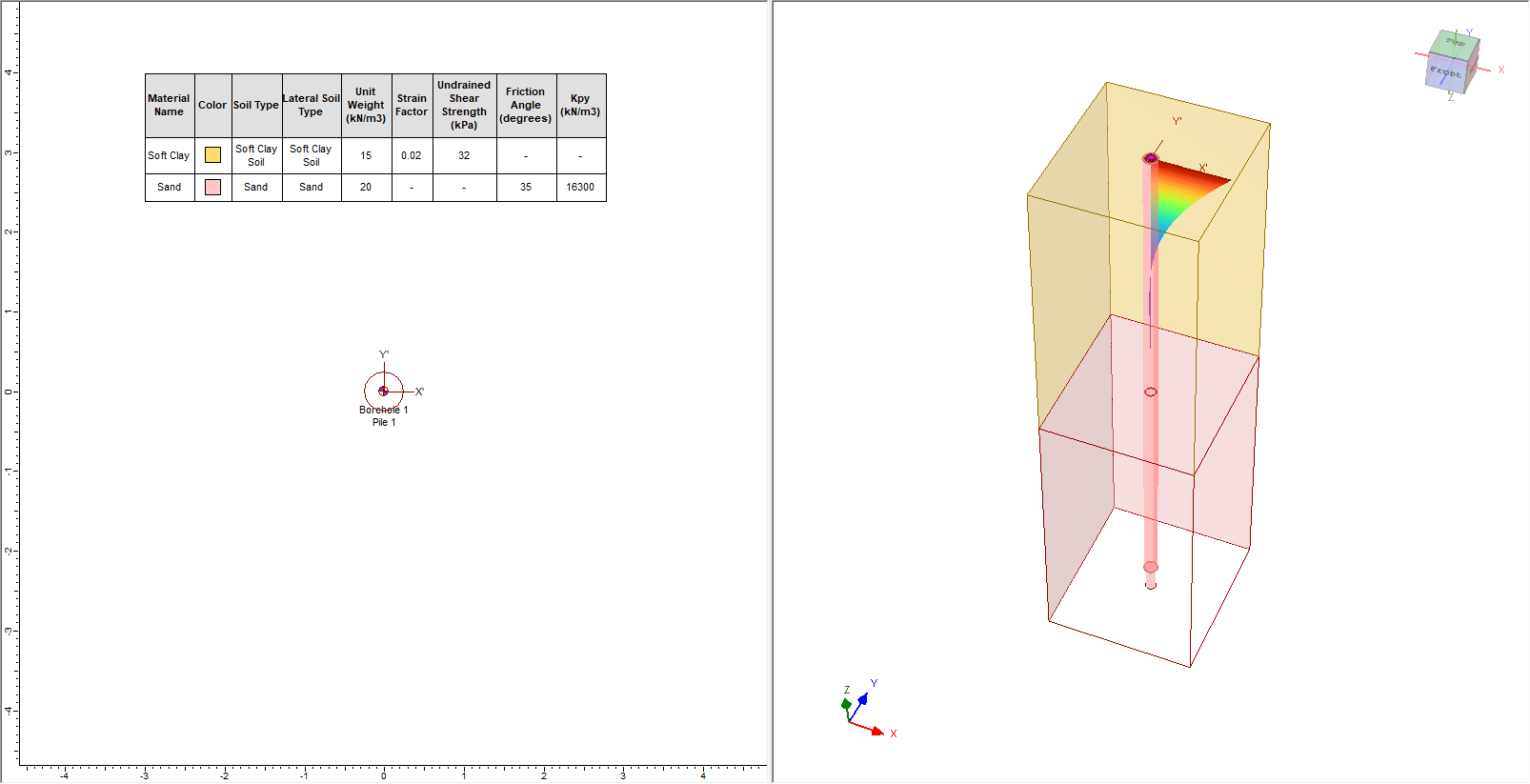
Once added, the tables may be edited, moved, or formatted to your specifications.
This concludes the Lateral Pile Analysis Tutorial. You may now exit the RSPile program.